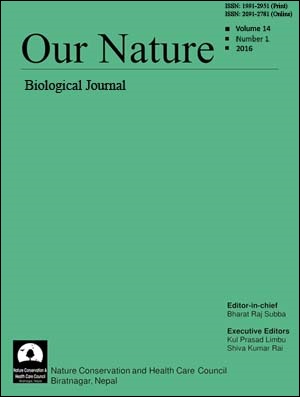Conflict due to Assamese Macaques (Macaca assamensis McClelland 1840) and crop protection strategies in Kali-gandaki River Basin, Western Nepal
DOI:
https://doi.org/10.3126/on.v14i1.16449Keywords:
Assamese Monkey, Crop damage, Western Nepal, QuestionnaireAbstract
This study was conducted on conflict due to Assamese Macaques (Macaca assamensis McClelland 1840) and crop protection strategies in Kaligandaki river basin, Baglung and Parbat Districts, Western Nepal. Field survey was conducted from 25 October to 22 December, 2015. Questionnaire survey was carried out to estimate the crop protection strategies and crop damaged by the macaque with the local inhabitants in the Kaligandaki River Basin VDCs. Stratified random sampling method was used to select respondent for the questionnaire survey. Out of 654 river basin households, 92 respondents were selected as sample size from the study area. Maize was the highest raided crop 46.95% followed by 15.91% paddy, 15.11% potato, 10.84% millet, 6.88% wheat, 2.05% pulses, 1.59% fruits and 0.66% vegetables. The most commenly used crop protection strategy in guarding their field were by constant vigilance 50%, 25% of field owners use “Scarecrows” 20% used dogs, 5% farmers used tin-box and catapult to chase the macaques from the crop fields.

This work is licensed under a Creative Commons Attribution-NonCommercial 4.0 International License.
Downloads
Downloads
Published
How to Cite
Issue
Section
License
This license enables reusers to distribute, remix, adapt, and build upon the material in any medium or format for noncommercial purposes only, and only so long as attribution is given to the creator.




